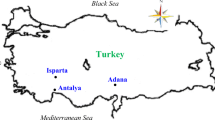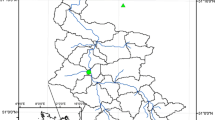Abstract
This study compares the accuracy of three different neural computing techniques, multi-layer perceptron (MLP), radial basis neural networks (RBNN), and generalized regression neural networks (GRNN), in modeling soil temperatures (ST) at different depths. Climatic data of air temperature, wind speed, solar radiation, and relative humidity from Mersin Station, Turkey, were used as inputs to the models to estimate monthly ST values. In the first part of the study, the effect of each climatic variable on ST was investigated by using GRNN models. Air temperature was found to be the most effective variable in modeling monthly ST. In the second part of the study, the accuracy of GRNN models was compared with MLP, RBNN, and multiple linear regression (MLR) models. RBNN models were found to be better than the GRNN, MLP, and MLR models in estimating monthly ST at the depths of 5 and 10 cm while the MLR and GRNN models gave the best accuracy in the case of 50- and 100-cm depths, respectively. In the third part of the study, the effect of periodicity on the training, validation, and test accuracy of the applied models was investigated. The results indicated that the adding periodicity component significantly increase models’ accuracies in estimating monthly ST at different depths. Root mean square errors of the GRNN, MLP, RBNN, and MLR models were decreased by 19, 15, 19, and 15 % using periodicity in estimating monthly ST at 5-cm depth.















Similar content being viewed by others
References
Adamowski J, Karapataki C (2010) Comparison of multivariate regression and artificial neural networks for peak urban water-demand forecasting: evaluation of different ANN learning algorithms. J Hydrol Eng 15(10):729–743
Bilgili M (2010) Prediction of soil temperature using regression and artificial neural network models. Meteor Atmos Phys 110:59–70
Bilgili M, Sahin B, Sangun L (2013) Estimating soil temperature using neighboring station data via multi-nonlinear regression and artificial neural network models. Environ Monit Assess 185:347–358
Cigizoglu HK (2005) Generalized regression neural network in monthly flow forecasting. Civ Eng Environ Syst 22(2):71–81
Fernando DAK, Jayawardena AW (1998) Runoff forecasting using RBF networks with OLS algorithm. J Hydrol Eng 3(3):203–209
Gao Z, Horton R, Wang L, Liu H, Wen J (2008) An improved force-restore method for soil temperature prediction. Eur J Soil Sci 59:972–981
García-Suárez AM, Butler CJ (2006) Soil temperatures at Armagh Observatory, Northern Ireland, from 1904 to 2002. Int J Climatol 26:1075–1089
George RK (2001) Prediction of soil temperature by using artificial neural networks algorithms. Nonlinear Anal 47:1737–1748
Hu Q, Feng S (2003) A daily soil temperature dataset and soil temperature climatology of the contiguous United States. J Appl Meteorol 42:1139–1156
Jackson TS, Mansfield K, Saafi M, Colman T, Romine P (2008) Measuring soil temperature and moisture using wireless MEMS sensors. Measurement 41:381–390
Jebamalar AS, Raja SAT, Bai SJS (2012) Prediction of annual and seasonal temperature variation using artificial neural network. Indian J Radio Space Phys 41:48–57
Kang S, Kim S, Oh S, Lee D (2000) Predicting spatial and temporal patterns of soil temperature based on topography, surface cover and air temperature. For Ecol Manag 136:173–184
Kim S, Singh VJ (2014) Modeling daily soil temperature using data-driven models and spatial distribution. Theor Appl Climatol. doi:10.1007/s00704-013-1065-z
Kisi O (2006) Generalized regression neural networks for evapotranspiration modelling. Hydrol Sci J 51(6):1092–1105
Kisi O (2007) Streamflow forecasting using different artificial neural network algorithms. J Hydrol Eng 12(5):532–539
Kisi O (2009) Daily pan evaporation modelling using multi-layer perceptrons and radial basis neural networks. Hydrol Process 23:213–223
Kisi O, Tombul M (2013) Modeling monthly pan evaporations using fuzzy genetic approach. J Hydrol 477:203–212
Kisi O, Kim S, Shiri J (2013) Estimation of dew point temperature using neuro-fuzzy and neural network techniques. Theor Appl Climatol 114:365–373
Mazou E, Alvertos N, Tsiros IX (2012) Soil temperature prediction using time-delay neural networks. In: CG, Helmis and PT Nastos (eds) Advances in meteorology, climatology and atmospheric physics. Springer Atmospheric Sciences
Mihalakakou G (2002) On estimating soil surface temperature profiles. Energy Build 34:251–259
Palani S, Liong S, Tkalich P (2008) An ANN application for water quality forecasting. Mar Pollut Bull 56(9):1586–1597
Paul KI, Polglase PJ, Smethurst PJ, O’Connell AM, Carlyle CJ, Khanna PK (2004) Soil temperature under forests: a simple model for predicting soil temperature under a range of forest types. Agric For Meteorol 121:167–182
Rahimikhoob A (2009) Estimating daily pan evaporation using artificial neural network in a semi-arid environment. Theor Appl Climatol 98:101–105
Rahimikhoob A (2010) Estimation of evapotranspiration based on only air temperature data using artificial neural networks for a subtropical climate in Iran. Theor Appl Climatol 101:83–91
Rezaeian-Zadeh M, Zand-Parsa S, Abghari H, Zolghadr M, Singh VP (2012) Hourly air temperature driven using multi-layer perceptron and radial basis function networks in arid and semi-arid regions. Theor Appl Climatol 109:519–528
Specht D (1991) A general regression neural network. IEEE Trans Neural Netw 2(6):568–576
Sudheer KP, Gosain AK, Ramasastri KS (2003) Estimating actual evapotranspiration from limited climatic data using neural computing technique. J Irrig Drain Eng 129(3):214–218
Tabari H, Marofi S, Sabziparvar AA (2010a) Estimation of daily pan evaporation using artificial neural network and multivariate nonlinear regression. Irrig Sci 28:399–406
Tabari H, Marofi S, Zare Abyaneh H, Sharifi MR (2010b) Comparison of artificial neural network and combined models in estimating spatial distribution of snow depth and snow water equivalent in Samsami basin of Iran. Neural Comput Applic 19:625–635
Tabari H, Sabziparvar AA, Ahmadi M (2011) Comparison of artificial neural network and multivariate linear regression methods for estimation of daily soil temperature in an arid region. Meteor Atmos Phys 110:135–142
Trajkovic (2010) Testing hourly reference evapotranspiration approaches using lysimeter measurements in a semiarid climate. Hydrol Res 41(1):38–49
Trajkovic S, Stankovic M, Todorovic B (2000) Estimation of FAO Blaney-Criddle b factor by RBF network. J Irrig Drain Eng 126(4):268–271
Wu W, Tang X-P, Guo N-J, Yang C, Liu H-B, Shang Y-F (2013) Spatiotemporal modeling of monthly soil temperature using artificial neural networks. Theor Appl Climatol 113:481–494
Zanetti SS, Sousa EF, Oliveira VPS, Almeida FT, Bernardo S (2007) Estimating evapotranspiration using artificial neural network and minimum climatological data. J Irrig Drain Eng 133(2):83–89
Zounemat-Kermani M (2012) Hourly predictive Levenberg–Marquardt ANN and multi linear regression models for predicting of dew point temperature. Meteorog Atmos Phys 117(3–4):181–192
Zounemat-Kermani M (2013) Hydrometeorological parameters in prediction of soil temperature by means of artificial neural network: case study in Wyoming. J Hydrol Eng 18(6):707–718
Zounemat-Kermani M (2014) Principal component analysis (PCA) for estimating chlorophyll concentration using forward and generalized regression neural networks. Appl Artif Intell 28(1):16–29
Acknowledgment
This study was partly supported by The Turkish Academy of Sciences (TÜBA). The first author would like to thank TÜBA for their support of this study.
Author information
Authors and Affiliations
Corresponding author
Rights and permissions
About this article
Cite this article
Kisi, O., Tombul, M. & Kermani, M.Z. Modeling soil temperatures at different depths by using three different neural computing techniques. Theor Appl Climatol 121, 377–387 (2015). https://doi.org/10.1007/s00704-014-1232-x
Received:
Accepted:
Published:
Issue Date:
DOI: https://doi.org/10.1007/s00704-014-1232-x




